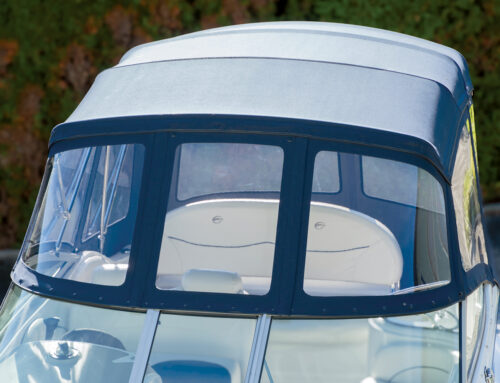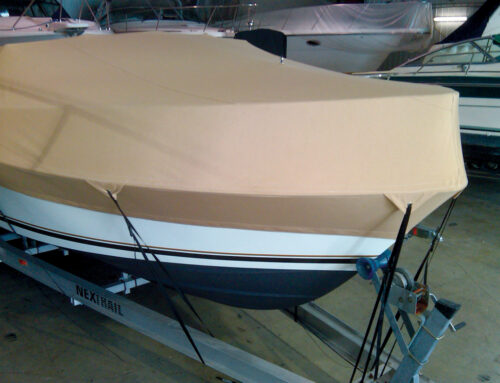Trusted tips for creating custom covers
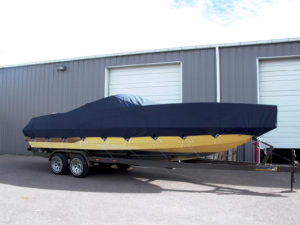
Paul Charpentier of Paul’s Custom Canvas, Denver, Colo., uses photos on his website to guide customers. Charpentier walks them through the discovery process by commenting on the photos. Charpentier’s covers are designed for the long distances boats are trailered in his region, and to allow snow to slough off. Photo: Paul Charpentier.
“Travel covers are notoriously good and bad,” says Steve Griffith, owner of Marine Tops Unlimited in Madison, Wis. “The good part is they will keep your boat clean and dry.” The downside is that the wind created by driving down the highway can cause the cover to billow out, blow around and damage both the cover and the surface of the boat.
Full-size travel covers need to fit snugly and attach to the boat or trailer to prevent them from billowing in the wind. Smaller versions cover part of the boat: the bow-well, the cockpit, or the cockpit and the windshield.
A full-size mooring cover covers the entire boat, including the rubrail. They are best at a dock, protecting all the top surfaces of the boat and keeping the boat clean and dry. They are typically secured to the boat with a draw cord, snaps or tie-downs.
Creating a successful cover depends on the fabricator’s critical first conversation with the boat owner, as well as the subsequent planning, design, execution and installation.
For Griffith, the primary determinant is “where the boat lives.” Is it in the water at dockside, on a trailer in a garage or perhaps in the backyard under a tree? Will the cover be removed every weekend or will it cover a cockpit full of fishing gear for a couple of highway trips each year? Once you determine those basic ground rules, then it becomes a process of figuring out which cover is going to do the best job for the customer, and what material to use.
Paul Charpentier of Paul’s Custom Canvas, in Denver, Colo., uses the photos on his website to guide the conversation with his customers, who come from any of several neighboring states. The customer points to photos of various covers and Charpentier walks them through the discovery process by referring to and commenting on the photos. His covers are designed to travel the long distances boats are typically trailered in his region, as well as allow snow to slough off before accumulating and damaging the cover and the boat.
In Wisconsin, Griffith designs travel covers with low profiles to minimize buffeting. He designs mooring covers with a high center to ensure water runs right off, avoiding problems like mold and mildew.
Mike Johnson, owner of Mike’s Marine Custom Canvas in Virginia Beach, Va., says, “I tell people not to trailer with a cover. But if they insist, then we charge them a little bit extra and make the cover super form-fitted.”

Attached with snaps, cockpit covers are taut, use less material, present lower profile and have less wind resistance. Photo: Mike Johnson, Mike’s Marine Custom Canvas, Virginia Beach, Va.
Johnson designs travel covers to fit the bow “like a sock over your toe,” then pull back and secure it with suction cups and adjustable buckles. Instead of using webbing as a draw cord around the entire boat, Johnson developed the adjustable buckle and webbing system that he places at critical points on the boat: aft corners, engine mounts and around pulpits.
Regardless of how effective tie-downs are, a cover on a trailered boat must fit well enough to minimize wind resistance and flapping. The best practices are learned through experience, from other fabricators through the Marine Fabricators Association and dedication to constantly improving the product.
“A lot of times I follow my customers down the road after they get the cover to see how the cover reacts,” Johnson says. “It gives me a good idea of how to design the next one.”
For customers who trailer their boats on a regular basis, Griffith recommends a cockpit cover. These covers fit from the stern to the windshield frame or wrap all the way to the windshield’s base, protecting instruments, upholstery and gear in the cockpit. Attached with snaps, cockpit covers are taut, use less material, present a lower profile and have less wind resistance. A full cover may not actually protect the boat underway because the action of the fabric flapping against the gel coat can dull the finish. Cockpit and bow-well covers also flutter in the wind, but the stress on the cover and gel coat is minimized by the lower profile.
Johnson generally uses Sunbrella for covers, especially when the customer already has canvas on his boat and wants the new cover to match. For larger covers, he uses polyester. “It’s a little more flexible than acrylic, more tear resistant and abrasion resistant.”
Griffith also uses Sunbrella for many covers, noting it is easy to work with and is breathable. “If it’s a boat that’s going to live on a boat hoist or in a garage, then a totally breathable fabric with a little less abrasion resistance is a good way to go,” he says. “However, if the boat is going to go down the road a lot, you need to build something that has a very high abrasion rate.” Then he uses a coated polyester for the added abrasion resistance with additional reinforcement at all wear points, windshields and deck cleats.
Charpentier uses Sunbrella for convertible tops and WeatherMax for larger travel covers, since both fabrics stand up well in the intense sunlight at high altitudes.
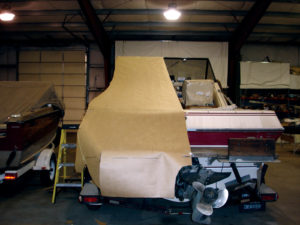
Key to building a successful boat cover is a good pattern. The best patterning material depends largely on the size and the style of cover and the boat’s location. When boats are trailered to the canvas shop, fabricators can pull patterns while protected from the weather, using craft paper. The paper comes in a variety of widths ans is easy to correct and store. Photo: Paul Charpentier.
Fasteners often affect the cover’s performance while traveling down the highway. “If you take the trailer on the highway and you’re going 50 to 75 mph, that’s hurricane force wind,” Johnson says. “The appropriate fastener in the right spot will ensure the cover’s performance. If it’s a cover that snaps on rather than straps on, we put snaps underneath, toward the ‘south pole’ of the rubrail about 1/4-inch from the fiberglass. The cover wraps around and snaps to it. You can actually trailer down the road with a cover like that. There is a lot of gripping power in the snap when it’s being pulled sideways and gets leveraged around the rubrail.”
Johnson further reinforces the snaps by installing Lift-the-Dot fasteners just above the standard “button” snaps at critical locations: at the bow and the back corners. “As long as that ‘keystone’ snap doesn’t come unsnapped, the rest of them are going to stay there,” he says. “I’ve had clients drive four hours to Cape Hatteras with their boat cover in the middle of the night, and they get down there with everything in place.”
Key to building a successful boat cover is a good pattern. The best patterning material depends largely on the size and style of cover and the boat’s location. When boats are trailered to the canvas shop, fabricators can pull patterns while protected from the weather, using craft paper. The paper comes in a variety of widths so there’s little waste, and it’s easy to correct and store, allowing the build up of an inventory of patterns.
“If I already have a pattern for a particular boat, I’ve just saved myself an hour’s worth of time, plus the drive out to go measure the boat,” Griffith says. “I’ve saved the customer time to not have to bring his boat to me. Time is saved since a pattern in inventory is ready to use. All I have to do is pull that pattern off the shelf, lay it down and it’s ready. I just mark the fabric, cut the fabric and sew it together.”
If a boat is moored at a dock, then patterning takes place on the boat, over the water and in the weather. In these cases, clear plastic works best. It’s easier to manage when patterning a full cover, which can take up to 30 to 35 yards of fabric, and the clear plastic makes it possible to create accurate patterns for complex covers.
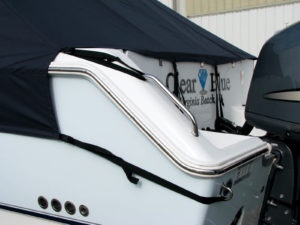
The adjustable buckle and webbing assembly secures the back corners of the cover made by Mike’s Marine Custom Canvas, Virginia Beach, Va., Mike Johnson uses similar assemblies around pulpits, engine cut outs, and across zippers joining two halves of a large cover. Photo: Mike Johnson.
Johnson begins full cover patterns that go over the rubrail with a fitted “skirt” by putting strapping tape on the rubrail, then double-sided tape on top of that. “We put the strapping tape on, mark the seam line on there with match marks and zipper marks and put the sticky tape over that. Then we pull the pattern,” he says. The two pieces have to fit together at that seam. “We’ll mark every third screw on the rubrail; that’ll be a match mark,” Johnson continues. “Every 18 inches we’ll have a little tick mark to match the top section to the bottom. That way, you can pattern the top, take it off and you can stand where that pattern was, then reach over the gunwale to pattern the skirt—even when the boat’s on a lift or in the water. It’s a little more time consuming, but we get a nice tight fit and a product that sells more covers to the neighbors down the canal or the guy down in the marina.”
Griffith’s business has two locations: one retail outlet, where customers can bring their boats for patterning, and one where all production sewing is done. He uses his mobile facilities to pattern at the customer’s house or at a dock. This frees Griffith to schedule patterning within a few days of the customer’s first phone call. The cover may take a couple of weeks to complete at his sewing facility, but in the meantime, he is free to pull patterns on additional boats. Organizing his production process this way has given Griffith a competitive edge in his area. “I’ve done two things now,” Griffith says, “first of all, the customer is getting immediate service. The second is that I’ve just taken him out of the market by giving him immediate service.”
The pressure to get something done right away is off, so the customer is likely to stop shopping. In addition, Griffith takes the finished cover to the boat owner’s home and installs it there, saving the time and effort needed to trailer the boat to Griffith’s shop.
Excellent customer service, coupled with a custom-designed and well-fit cover can ensure referrals and repeat business.
Mary Jo Morris owned and operated Berkeley Marine Canvas for five years. She lives with her husband in Point Richmond, Calif.
 TEXTILES.ORG
TEXTILES.ORG 




